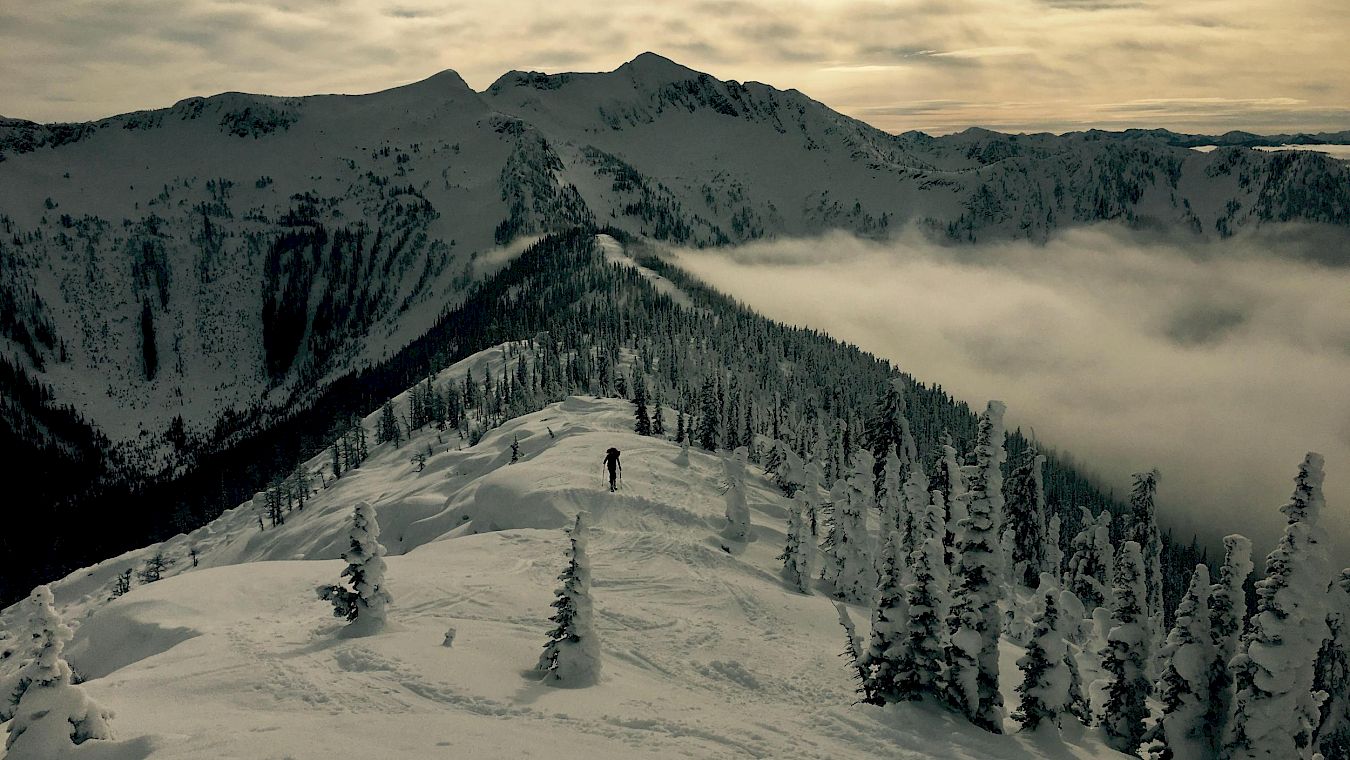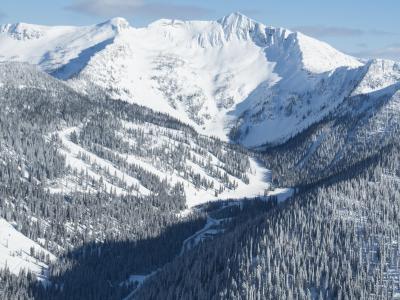
Beyond the Boundary
On a brisk February morning at Whitewater Ski Resort, my two friends and I board the Silver King chairlift. Besides our backpacks, which we pull around to our laps as we sit, there’s nothing that visually sets us apart from the other skiers. But our plan for the day is radically different. Once we get to the top of the lift we won’t be skiing down—we’ll be going further up. We’re headed into the backcountry, the wilderness beyond the ski resort boundaries.
We are not alone. According to the Snowsports Industries of America (SIA), backcountry skiing—also known as alpine touring to include snowboarders—is growing while participation in resort skiing and snowboarding remains flat. Research compiled by SIA shows 1.4 million Americans skied or snowboarded in the backcountry during the 2018-19 season. That’s more than double 650,000 participants in 2010 (as estimated by wildsnow.com, the most accurate approximation from that time). Alpine touring’s popularity is matched by a surging demand for backcountry gear. In the last decade, sales of touring equipment (skis, boots, bindings) has increased 400 percent, according to the American market research firm NDP Group. In the same time period, sales of backcountry safety gear (avalanche transceivers, probes, shovels, skins) has increased more than 800 percent.
For me, the trend speaks to a personal need to feel a more authentic connection to nature. Backcountry skiing demands that I study slope angle and snowpack, that I understand how wind and weather conditions will affect my ability to move safely in the terrain. The pursuit has required years of education, training, and experience. In other words, the mountain asks a lot of me when I backcountry ski. And as in any strong relationship, the mountain gives back in equal proportion. I see sides of her that she doesn’t show to just anyone.
Two years ago, when I moved to Nelson, British Columbia, Whitewater Ski Resort became my launch point for exploring the backcountry. The resort is perfectly positioned beneath Ymir, a 2,400-meter peak whose extensive alpine ridgelines hug Whitewater’s inbound terrain on both sides. The lifts get you three-quarters of the way up to the ridge, where a plethora of backcountry runs await, from the mellow glades known as Acidophilus to the bold shafts of Prospector. Whitewater supports backcountry-bound skiers with one-up lift rides for $35 each or a 10-pack Backcountry Explorer Pass for $250.
From the top of the Silver King chairlift, my friends and I traverse 30 meters to the Ski Area Boundary sign. We pull our skins out of our backpacks and attach them to the bottom of our skis. Beyond the resort’s boundaries, we are no longer under the protection of Whitewater’s ski patrol. We check that our transceivers, specialized radio transceivers strapped across our chests, are switched on and transmitting. As I step out of bounds, I recite transceiver-shovel-probe in my head, a backcountry mantra that describes the trio of essential gear required in an avalanche rescue. The transceiver allows us to track and be tracked, no matter how deeply buried. The probe pinpoints an avalanche victim’s exact position in the snow, and the backcountry-specific shovel enables the victim to be dug up. Based on the avalanche conditions report I’d read the night before, an avalanche is not likely on the aspect we’re skiing today. But its critical to be prepared—as much as a person can be among the inherent uncertainty of the backcountry.
As we skin up to the ridge, my friends and I fall into a steady rhythm. Spruce trees, the tall, narrow sentinels of these slopes, surround us in silent watch, the evergreen of their boughs overruled by fresh white snow. My ears tune into the swoosh of Gortex pants and the crunch of snow as I slide one ski in front of the other. We’re aiming for Half Dome, a rounded 2,328-meter peak that’s second only to Ymir’s pyramid in terms of recognizable features from the base. The 430-meter uphill effort will earn us access to Ymir’s powder-packed bowl.
After about 15 minutes, we reach the ridgeline and pause to take in the panorama off the back. Peering across the basin into the forested slopes beyond, I recall that we’re looking straight into a provincial park—26,199 undeveloped hectares without a single trail, let alone a campground, stretching all the way to the West Arm of Kootenay Lake. I steal a glance at my friends. Each wears a wide grin that mirrors my own. I exhale. This is why we’re here.
We turn east and follow the ridge, switch-backing up just one sharp ascent before reaching a fractured rock wall that guards the start of a short boot-pack section. I click out of my skis and latch them onto my backpack. One by one, we hoof it up the narrow passage skirting the rock to reach the other side. Once we’ve got our skis back on, we enjoy a long, relatively flat traverse over to the base of Half Dome. Then it’s a 20-minute slog up the backside to the top. Each of us knows the extra effort is not necessary, as we’ll need to turn around and come back down in order to access the saddle that gets us into Ymir Bowl, but we want the sensation of the summit.

Photo by Steve Ogle. Half Dome is the rounded peak on the left of the ridgeline.
Standing atop Half Dome affords a rare 360-degree ocean of mountaintops rippling all the way back to the horizon. Looking out, I understand that Ymir, as the dominant peak on Whitewater’s skyline, is really just one of many equally charismatic, craggy peaks, each with its own alpine bowls and chutes, and tree-covered glades below. How many more, it’s hard to say. Dozens, hundreds? I take a deep breath, inhaling the magnanimity of the mountainscape. As I un-glove one hand to take a photo, I realize its painfully cold up here. My eyelashes are iced, and stray pieces of hair from my braid have turned white. It’s time to go.
We peel our climbing skins from our skis and stow them back in our packs, swapping them for new layers of protection: windproof jacket for the core, goggles for the eyes, helmet for the head. I slide down the backside of Half Dome and around to the saddle that marks our entry into the bowl. From my vantage, the Whitewater Day Lodge is a Lego block on the valley floor. Sluice Box, the green run leading back to it, is a piece of white ribbon.
I look back at my friends. “See you on the flip side,” I say, dropping into the Ymir Col. But after three turns I can tell it’s not my day. My legs are heavy, laden down, I presume, by the two-hour effort it took to get here. Fortunately my friends aren’t in a hurry. We take our time in the steeps, then thread the trees on Scob’s Knob. When we hit the mellower terrain on the bottom half of the bowl, I feel my legs perk up, and I begin to enjoy the coldsmoke cruise back into the resort.
Inside the lodge, I run into Lori Anne Donald, who is training for the 2019 World Championships in Switzerland next month. She tells me she took the Summit lift, the chair on the opposite side of the resort from Silver King, and skinned up to the ridgeline from there. She followed the ridge all the way to Ymir Peak, dropping into the bowl from the Ymir Bench. Hers was a considerably longer tour than the one I did, and more challenging. She says it’s her absolute favorite route from Whitewater. “It’s so beautiful, the views off both sides, and the way the light hits the ridgeline from that side,” she says.
I make a mental note to begin researching Lori Anne’s favorite route. What’s the snowpack been doing on the north-facing aspect? Does the skin track go up and over, or around, Hummingbird peak on its way to Ymir? How’s the wind effect over on that side? From the base, I can look up and see the twin Prospector shafts, pouring down the treed slope like white waterfalls. I wonder what it’s like to peer down them from the ridge. My legs need a bit of recovery, but my imagination is already alight. I can’t wait for my next journey into the backcountry.
Written by Jayme Moye - Whitewater Writer-in-Residence 2019/20
Cover photo by Brad Steele